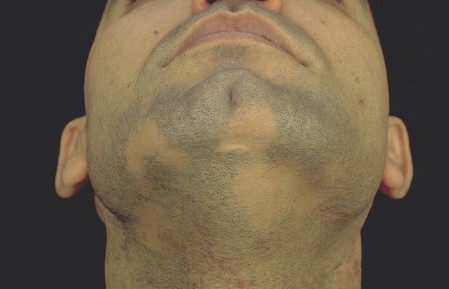“Around three years ago, I noticed a random bald spot in my beard about the size of a large coin. This spot gradually increased in size, although the hair eventually grew back after about a year. I didn’t see this again for two or three years until around two months ago when I spotted another large bald patch in my beard. There are now five or six of these patches, plus some smaller ones.”
Has something similar happened to you? The appearances of bald patches in the beard, on the scalp or elsewhere on the body is a condition called alopecia areata. To find out more about this ailment and how you can deal with it, read on.

Bald Patches in Beard – You Have Developed Alopecia Areata
Hair loss conditions are known as alopecia. There are several different types of alopecia:
When the hair loss occurs in patches, this is termed alopecia areata. It can develop on any area of the body, including the scalp.
Loss of all the hair on the scalp is known as alopecia totalis.
Complete hair loss all over the body is called alopecia universalis.
So, if you find bald patches in beard, it must be alopecia areata. Alopecia areata is a type of organ-specific autoimmune disease. The immune system helps us to defend against foreign substances and infections. Autoimmune diseases develop when the immune response is mistakenly directed against part of your own body. In the case of alopecia areata, it is the hair follicles that are being attacked.
The cause of alopecia areata remains a mystery, although some scientists think that genetics may be involved. The disease may develop when a genetically susceptible individual is exposed to some sort of trigger, e.g. a virus or particle in the environment, which provokes the immune attack on the hair follicles.
How Will the Bald Patches Develop?
Alopecia areata is typically characterized by the appearance of a bald patch in the beard or on the scalp. These patches are usually round and approximately the size of a large coin, and often develop fairly rapidly. However, the rest of the hair may remain healthy. Hair loss can be very distressing or embarrassing to the individuals involved since the condition is often first noticed by friends and acquaintances who can see the bald patches on the back of the scalp.
It can be hard to know exactly how a bald patch will develop once it is detected, although progression usually occurs in one of the following ways:
If you develop several bald patches at once, these may merge into one large bald area.
Alternatively, the patient may see large bald patches arise on their own. And then the patches of hair loss can develop in the eyebrows, eyelashes, or body hair. The complete loss of scalp hair is termed alopecia totalis.
You will often see regrowth within a few weeks. The regrowing hair may first be a different color, looking gray or white. However, your original hair color will usually reappear after a few months.
You may see further bald patches developing after you have noticed the initial one. These extra bald spots may even appear following regrowth in the first patch. Over time, it may seem as though the bald patch is moving around different regions of the scalp or beard.
One in five patients sees changes in their nails, with the nails becoming pitted or ridged.
How to Deal With Bald Patches
Although alopecia areata cannot be cured, there are treatments available that may promote hair regrowth in a random bald spot. Common remedies for alopecia areata include:
Corticosteroids. These can be delivered by injection into the affected area, orally through pills, or topically by applying corticoid-containing ointments, creams and foams. The results may only appear gradually.
Anti-inflammatory drugs. These are often used for auto-immune diseases.
Topical contact allergens/sensitizers (topical immunotherapy). If you have extensive or recurring hair loss, this type of medication can be useful for stimulating regrowth through promoting an inflammatory response.
Rogaine (minoxidil). Rogaine is used as a topical remedy for pattern baldness. However, it can take up to 12 weeks for regrowth to appear and even then, the results can be not that good.
Further treatments. Medication used for other auto-immune diseases and psoriasis can also be employed to treat alopecia areata.
In addition to the conventional therapies, some patients find the following cosmetic and preventative measures useful:
The bald patches can be protected against the elements using wigs, scarves and hats. If the bald spots are not covered, it is advisable to apply high SPF cream to exposed areas in sunny weather.
Make-up may be used to hide the bald patches.
Some people think that stress may be a factor in the development of alopecia, so try to take occasional breaks for relaxation.
A lot of patients with alopecia can find the hair loss upsetting. It may help to find a therapist or if there are any alopecia support groups in your area.

View All Comments /Add Comment